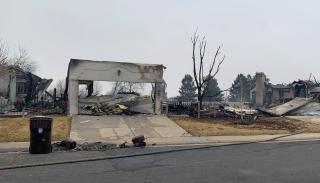
Story
Readings for a Too-Long Fire Season
Six books about wildfire that are helping us think about the future of our homes on the range.
As if we needed yet another, the closing hours of 2021 were a reminder that there is no such thing as fire season in Colorado anymore. Every time of year is fire season now. With the embers of the devastating Marshall Fire barely cooled, like many Coloradans, we’ve been casting around for new answers to the big questions: How and why did this happen? How could this happen in December? When and where will the next fire happen?

Homes still smolder in the heart of Louisville after the costliest fire in Colorado history destroyed part of the town on the last day of 2021. The suburb is far from the forested foothills that many associate with areas typically under threat from wildfire.
The full answers to these questions are complex. Anthropogenic climate change is certainly playing a role in pushing these blazes deeper into winter and closer to the Front Range urban corridor. But a warming, drying climate isn’t the whole story. More than a century of state and federal forestry policy, along with overly rosy estimations about the risks of homebuilding in disaster-prone areas, have left us more nervous than ever about living in fire country.
But luckily for those of us who want to make better sense of too-familiar tragedies, historians and novelists offer unique perspectives. And they haven’t been silent on the subject of fires. From accounts of the brave women and men who lost their lives protecting our homes from flame, to in-depth examinations of humanity’s relationship with the most essential of elements, here are six of the books we’re reading right now as we search for answers amongst the ashes.
1. Wilderburbs: Communities on Nature’s Edge by Lincoln Bramwell (2016)
The author, who should know a thing or two about fire since he’s the Chief Historian for the United States Forest Service, documents the emergence of vulnerable suburban communities built into disaster-prone hillsides all across the American West. He calls them “Wilderburbs” for short. From his unique perspective inside the agency most responsible for forest fire management, Bramwell asks us to consider the future of homes in the West.
2. Paradise on Fire by Jewell Parker Rhodes (2021)
In this novel geared towards school-age readers, award-winning author Jewell Parker Rhodes brings us a coming-of-age story about a young Black girl who confronts a wildfire years after she lost her parents in another fire. Rhodes has a knack for helping young learners work through issues like trauma, race, and climate change in the context of a rapidly changing world.
3. Fire on the Mountain: The True Story of the South Canyon Fire by John N. Maclean (1999)
The 1994 South Canyon Fire was one of Colorado’s deadliest. Fourteen firefighters lost their lives, and Maclean’s portraits of the fallen pull back the curtain on the increasingly familiar world of wildland firefighting.
4. The Pyrocene: How We Created an Age of Fire, and What Happens Next by Stephen J. Pyne (2021)
Pyrocene is a brief (but fascinating) survey of humanity’s relationship to fire. Pyne is one of the leading scholars of fire history, and his provocative style leaves readers thinking deeply about one of humanity’s greatest tools and oldest foes.
5. Gifford Pinchot and the Making of Modern Environmentalism by Char Miller (2001)
Gifford Pinchot could be the most important bureaucrat you’ve never heard of. As the first person to lead the United States Forest Service, Pinchot’s policies and attitudes still shape this country’s relationship to its forests.
6. The Big Burn: Teddy Roosevelt and the Fire that Saved America by Timothy Egan (2009)
One of the most acclaimed authors writing about the West today, Timothy Egan has a knack for helping readers put historical tragedy in context. With The Big Burn, Egan tells the story of a wildfire in Idaho, Washington, and Montana that scorched an area of forest the size of Connecticut, and the President who ushered in a new conservation movement in the United States.
